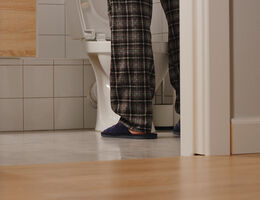
June 2, 2025— You may not hear many men complaining about nonstop dashes to the bathroom—but you should. Around 33 million people in the U.S. have overactive bladder (OAB). While it's more common in women, nearly 1 in 7 American men has the condition.
Treatment can help. But that starts with speaking up about the problem.
What is overactive bladder?
Overactive bladder (OAB) causes a sudden, strong need to pee. It can sometimes lead to leaks. In some cases, OAB can get so bad that you're unable to go at all. A temporary tube may be needed to drain the bladder.
Contrary to popular opinion, OAB is not just an annoying part of aging. It can seriously disrupt daily life. The good news: It's highly treatable.
A growing problem
According to a 2024 study published in Scientific Reports, OAB rates among men have been climbing. Between 2005 and 2008, 11.3% of U.S. men had OAB. That ticked up to 11.7% between 2009 and 2014. By 2020, 14.5% of American men had the condition.
While OAB is still most common among those age 60 or older, the condition didn't become more common in that age group. Instead, rates rose among younger adults—especially men in their 40s and 50s.
What causes OAB in men?
For about two-thirds of men who have OAB, the issue is caused by prostate problems. Weak bladder muscles can also contribute to OAB. Or it could be linked to blader stones or a bladder or prostate infection, which can irritate the urinary tract.
Neurological disorders, like Parkinson's disease, multiple sclerosis, diabetes or the after-effects of a stroke, may damage the nerves controlling bladder function. That can trigger symptoms of OAB.
In rare cases, bladder cancer might be the cause, so it's especially important to see a healthcare provider.
OAB is treatable
Because the most common cause of OAB in men is prostate problems, addressing the underlying issue treats OAB too. That might mean taking medications or—in some cases—having surgery to treat an enlarged prostate.
Your doctor might also recommend:
- Diet and exercise: Losing weight, improving your diet and quitting smoking can all help ease symptoms of OAB.
- Pelvic floor exercises: Kegel exercises can strengthen the muscles that help control urination.
- Fluid management and bladder training: Tracking your fluid intake and planning bathroom visits on a schedule can reduce urgency and frequency.
Speak up
Telling your doctor about bladder or prostate problems is the first step to getting the treatment you need—and improving your quality of life.
Sources
- American Academy of Family Physicians. "Overactive Bladder." https://familydoctor.org/condition/overactive-bladder.
- National Association for Continence. "Overactive Bladder in Men." https://nafc.org/bhealth-blog/overactive-bladder-in-men.
- National Association for Continence. "What Is Overactive Bladder (OAB)?" https://nafc.org/overactive-bladder.
- Scientific Reports. "Prevalence and Trends in Overactive Bladder Among Men in the United States, 2005–2020." https://www.nature.com/articles/s41598-024-66758-8.